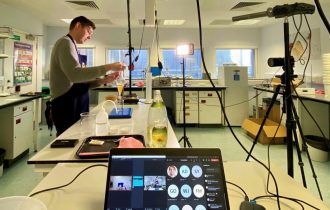The Role of Technology in Hybrid Learning

Hybrid learning, the combination of in-person and online instruction, has emerged as a powerful educational model that blends the benefits of face-to-face interaction with the flexibility and accessibility of digital platforms. Technology plays a crucial role in enabling and enhancing hybrid learning, offering innovative tools and resources that support student engagement, collaboration, and personalized learning experiences. This article explores the significant role of technology in hybrid learning, highlighting existing technologies and real-world examples of their implementation.
I. Facilitating Seamless Integration: Learning Management Systems
1. Learning Management Systems (LMS): The Foundation of Hybrid Learning
Learning Management Systems (LMS) provide the infrastructure for hybrid learning, serving as a central hub where instructors can manage and deliver course content, track student progress, and facilitate communication and collaboration. Platforms like Canvas, Blackboard, and Moodle are widely used in educational institutions to create a seamless integration of in-person and online components. These systems allow instructors to organize course materials, engage students through discussion boards and quizzes, and provide timely feedback. As education reformer John Dewey once said, “If we teach today as we taught yesterday, we rob our children of tomorrow.”
2. Cloud Computing: Ubiquitous Access to Educational Resources
Cloud computing has transformed the accessibility of educational resources, enabling students and educators to access course materials, documents, and collaborative tools from any device with an internet connection. Cloud-based platforms like Google Workspace and Microsoft 365 provide storage, file sharing, and real-time collaboration features, facilitating seamless access to educational resources. This flexibility empowers students to learn at their own pace and engage with materials from anywhere, breaking the barriers of time and location. As American computer scientist and technology entrepreneur Larry Page once stated, “The ultimate search engine would understand everything in the world. It would understand everything that you asked it and give you back the exact right thing instantly.”
II. Enhancing Student Engagement: Interactive Tools and Multimedia Resources
1. Interactive Learning Tools: Active Participation and Immediate Feedback
Technology offers a wide range of interactive learning tools that promote active student participation and provide immediate feedback. These tools include educational apps, gamification platforms, and online simulations. For example, platforms like Kahoot! and Quizlet engage students through interactive quizzes and games, making learning enjoyable and promoting knowledge retention. Similarly, online simulations in science and engineering subjects allow students to apply theoretical concepts in practical, virtual environments. As American psychologist William James once said, “The deepest principle in human nature is the craving to be appreciated.”
2. Multimedia Resources: Visualizing Concepts and Fostering Understanding
Multimedia resources, such as videos, animations, and infographics, play a significant role in hybrid learning by visualizing complex concepts and fostering understanding. Platforms like Khan Academy and TED-Ed offer a vast library of educational videos on various subjects, providing engaging and accessible explanations of challenging topics. These resources cater to diverse learning styles and preferences, facilitating personalized learning experiences for students. As American author and education activist Parker J. Palmer once emphasized, “Education is the kindling of a flame, not the filling of a vessel.”
III. Promoting Collaboration and Communication: Virtual Interactions
1. Virtual Communication Tools: Real-time Collaboration and Discussion
Virtual communication tools are essential for facilitating collaboration and discussion among students and instructors in a hybrid learning environment. Video conferencing platforms like Zoom and Microsoft Teams allow real-time interactions, enabling students to engage in group work, ask questions, and participate in class discussions. These tools create a sense of community and enable students to learn from and with their peers, even when physically distant. As American writer and futurist Alvin Toffler once said, “The illiterate of the 21st century will not be those who cannot read and write, but those who cannot learn, unlearn, and relearn.”
2. Social Learning Platforms: Building Networks and Communities
Social learning platforms provide spaces for students and educators to connect, collaborate, and share resources outside the traditional classroom setting. For instance, platforms like Edmodo and Schoology enable educators to create online communities where students can engage in discussions, ask questions, and share ideas. These platforms foster networking opportunities, allowing students to expand their knowledge beyond the classroom and connect with experts and peers worldwide. As American educational psychologist Lev Vygotsky once stated, “In collaborative learning, people are engaged in a collective enterprise that extends beyond the individual.”
Conclusion
Technology plays a crucial role in supporting and enhancing hybrid learning, providing the tools and resources necessary for seamless integration, student engagement, collaboration, and communication. From learning management systems to cloud computing, interactive tools, multimedia resources, virtual communication, and social learning platforms, technology empowers educators and learners to create dynamic and personalized learning experiences. As we embrace hybrid learning in education, it is important to harness the full potential of technology to unlock the possibilities of a truly inclusive, flexible, and effective educational landscape. To quote American futurist and author Arthur C. Clarke, “Any sufficiently advanced technology is indistinguishable from magic.” And in the realm of hybrid learning, technology truly works its magic to transform education.


